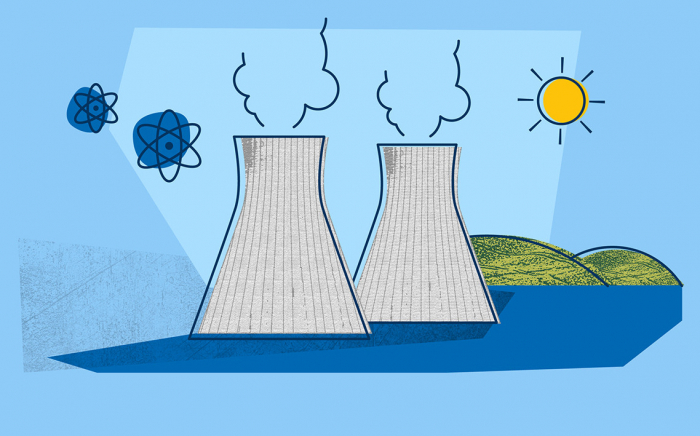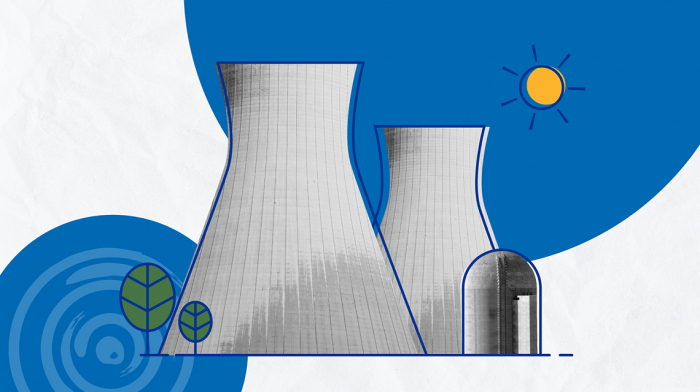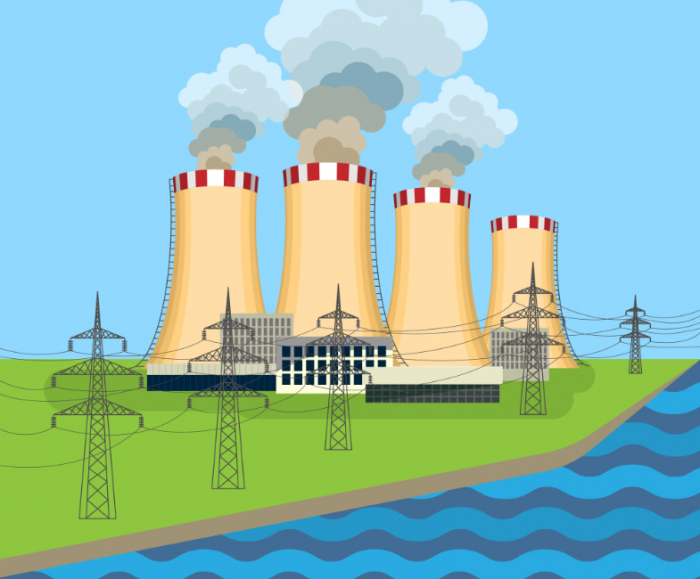‘Sea water is currently desalinated through membrane and chemical methods. The most practiced method is demineralizing water after evaporation, which requires vast amounts of energy. This automatically translates the solution of the water problem into the energy consumption plain’, says Islam Mustafayev, correspondent member at the Azerbaijan National Academy of Sciences (ANAS), General Director at the Institute of Radiation Problems and Doctor of Chemistry in his interview to AzVision.az.
Although oil and gas countries, and Azerbaijan is one, have sufficient energy reserves, employing traditional energy carriers cause more carbon dioxide emission, which interestingly, these countries are also required to limit. The international consensus is to achieve net zero carbon dioxide pollution by 2050. Azerbaijan, along with 198 countries, has assumed certain obligations through signing the Convention on Climate Change, the Paris Agreement, the decisions of the World Economic Forum, as well as the European Green Deal. These obligations introduce certain restrictions on the consumption of organic fuel (traditional energy carriers), for carbon dioxide causes climate change, temperature increase and, consequently, water shortage. Therefore, burning fuel is by no means an answer to water shortage problem.
The inevitable solution is to use renewable energy sources, such as solar, water, and wind energy. Rafael Grossi, General Director of the International Atomic Energy Agency (IAEA) says the countries that switch to renewable energy may face instability, because the field does offer opportunities, albeit very limited. The weather may not be favourable, for example. These instances introduce a need for a more reliable source, where nuclear energy comes to play.
‘Grossi reported that countries have allocated trillions of dollars to reduce the impact of greenhouse gases on climate change. If a small portion of the amount is spent on ensuring safety, nuclear energy will become a very reliable source both for energy consumption uses and desalination of sea water. It poses very few negative effects for the environment. Water desalination, on the other hand, is a huge energy intensive field.
The USSR authored one of the first experiments in the field in 1973, when they built a 350-megawatt nuclear reactor in Shevchenko (now Aktau), a Kazakhstani city on the Caspian coast. For comparison, the reactor that exploded in Chernobyl had a capacity of 1000 megawatts.
120,000 cubic metres of water a day was enough to meet the needs. A part of the energy produced at the reactor was even directed for electricity consumption. It was shut down as the USSR collapsed. But as far as I know, they are planning to restart it.’
- What is the experience in other countries in using nuclear energy to desalinate sea water?
‘Iran is planning to add 3 more plants next to the Nuclear Power Plant (NPP) built by Russia in Bushehr, an arid terrain, to desalinate sea water. Some of the plans include developing seawater desalination facilities next to the Akkuyu NPP built by Russia in Türkiye. There are 400 reactors around the world, producing nuclear energy. There used to be 456, but the plants that reached the end of their service life were shut down after the Chernobyl and Fukushima accidents. They went as far as reducing construction plans by 30%. The information I have is that as Grossi voiced his position, the countries with opposing views on nuclear reactors are also changing their positions.’
- Could Azerbaijan build an NPP to produce energy to desalinate the Caspian Sea waters?
‘Azerbaijan has sufficient experience in using nuclear energy and conducting research in the field. The IAEA was established in 1957 with the sole purpose of using nuclear energy for peaceful purposes. Since the USSR joined the agency, it was not long since Azerbaijan became a part of the movement. The Laboratory of Radiation Chemistry was established at the ANAS Institute of Petrochemical Processes in 1958. The laboratory set out to train personnel and build a certain potential as the initial goal. As the laboratory functioned for ten years, the USSR Cabinet of Ministers issued a decision to establish the Radiation Research Sector in Azerbaijan in 1969. The sector came a long way until 2002 as one of the most eminent research centres across the USSR. It was not spoken of much because it mainly focused on nuclear energy and radiation. When we worked there, we would send our articles to Moscow where they were reviewed. They were published only after approval, consequently no approval meant gathering dust in some drawer. What I am trying to say is that substantial work has been done throughout years with great personnel potential. Meanwhile, there was little public awareness in the field due to secrecy.
They decided to build a nuclear plant in Navai, Azerbaijan, in mid 1970s. 10 people, including me, were told about it and we were to come work there as we graduated from Kurchatov Institute in Obninsk. The 17 cottages built for the staff who would work in Navai are still there. They even laid the foundation of the reactor at the time. After various disputes, they finally froze the project after the Chernobyl incident.
President Ilham Aliyev signed a decree in May 2014 on building the Research Nuclear Reactor and establishing the Nuclear Research Centre. The issue was put back on the agenda. The IAEA also assigned us several projects to justify the feasibility study. The project lasted 7-8 years. The staff is there, documents have been received. Our country is rapidly building institutional and human potential to produce nuclear energy.’

- Hasn’t there also been a pilot project on desalinating the Caspian waters?
‘Indeed, there has. But it was done through chemical, membrane method, not through employing atomic energy. The Ministry of Ecology and Natural Resources built a pilot facility near Khidirli village on the Salyan road. The garden set up near the facility is irrigated with that water. They must have been getting good results.
We must consider several aspects. When our territories were under occupation, we could not access our small rivers in Karabakh and East Zangazur effectively. Even if we have access to them now, we must still prepare for the future. When the time arrives to say, ‘There is no water, it must be bought’, the prices will no longer be relevant. When people are suffering from thirst and environmental problems, profitability will not be measured. The priority will be the well-being of people and the human factor, not economic interests.’

- Are we late? Azerbaijan will probably set up to construct the nuclear reactor with another country. Major countries are in serious competition when it comes to this matter. Russia has even made an offer to Azerbaijan…
‘The projects assigned by the IAEA were carried out under the auspices of the Russian Rosatom. We must give credit where it’s due. Rosatom is far ahead in exploiting atomic energy to desalinate sea water. They have accumulated great experience in Shevchenko (Aktau). In any case, we must make a choice. We have fitting partners. Russia has built all the NPPs in the region, in Bushehr in Iran, in Akkuyu, Türkiye… Armenia has a nuclear plant in Metsamor and wants to build a second one. We are trying to put up strong opposition. The ESPOO convention obliges them to get permission of the neighbouring country, meaning us.
There is another interesting experience in the world: every country builds the NPP near the border with their neighbours. Lithuania has built one on the border with Belarus, Belarus has returned the favour. Georgia had built one in Tbilisi, which is 50 kilometres away from us. Metsamor is 70 kilometres away, the one in Türkiye only 15. This has been a practice to delegate much of the damage onto other countries in case of accidents.’
- This creates a controversy. We do not want Armenia to build a second nuclear plant. But we must also build our own reactor. How will we get their permission then?
‘We must reach a certain agreement. The main issue is not have the NPP close to the border. If Armenia builds one in Kirovakan (Vanadzor) or Amasya, we can’t get involved in their domestic matters. But the situation changes if they want it on the border.
The EIA, the environmental impact assessment norms, require projects to be sent to neighbouring countries before they are built. Azerbaijan also received the Metsamor project at the time. If we fail to respond within the time limit, we are considered to consent. Therefore, we must be and are ready.’
- International organizations must be studying the seismological conditions carefully prior to giving their consent. Isn’t Armenia a seismically unstable zone?
‘The break line runs in mere 8 kilometres from the Metsamor NPP. The station will be in grave threat if there is an earthquake. Meanwhile, we can be quite optimistic about Azerbaijan’s prospects on building a nuclear reactor for atomic energy to desalinate sea water.’
AzVision.az
More about:
















































